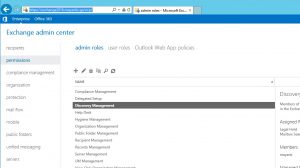Exchange Server 2016 Installation- part 2.
The mailbox server.
We are now going to install the exchange mailbox server role. Do keep in mind what mailbox is used for. Microsoft documentation says the following is the role of a mailbox server
- Mailbox servers contain the transport services that are used to route mail. For more information, see Mail flow and the transport pipeline
- Mailbox servers contain mailbox databases that process, render, and store data.
- Mailbox servers contain the client access services that accept client connections for all protocols.
Just keep this in mind: the actual mail is stored in a database that is stored on the mailbox server so if in the entire infrastructure- your mailbox server gets formatted (chees!) there is no way you can recover your emails. Now as this is one heck of a critical piece- Microsoft has provisioned redundancy for it. It is called DAG. A DAG is the clustered host of machine which will share the responsibilities of sharing the mailbox databases so that even if one server goes down- we can fall back to the other functional host.
This is not much to do apart from following the wizard, this technet article explains what you should do, only thing to keep in mind which is not written in this is to run UcmaRuntimeSetup.exe on the exchange mailbox which this link has not mentioned so far. https://technet.microsoft.com/EN-US/library/bb124778(v=exchg.160).aspx
There are couple of "gotchas" here- first, when you install the related features by the wizard- you will see that the wizard has failed complaining that some features are still missing. Well- its actually installed and you just have to reboot the machine to take this to effect. So just reboot the machine and then start the wizard again.
Now once the exchange gets installed, first thing we have to is to log inside exchange to see how things look like. the management tool for exchange is called exchange messaging center. This is a web based console used for managing and maintaining the Exchange. Though it is a very good tool to begin with for the rookies- it is best to familiarise yourself with the Grand dady of the Messaging center. It is called Exchange management Shell. EMS as it is called is the Powershell shell for managing exchange. There are many things that you cannot do with the Messaging center but can achieve with the Exchange messaging services. So to be an expert in exchange- you know what you have to do!
A quick tip- to open Exchange messaging center- you have to use https://localhost/ecp on the local host. On a member server; you will have to use: https://NameofServer/ecp. In my case the name of my mailbox server is exchange2016 so the URL for accessing the messaging center is https://exchange2016.mayanks.ga/ecp. Please note my domain is mayanks.ga- this is a publically registered domain for free. (checkout www.freenom.com for registering a free domain name for yourself!)
Well- once the exchange mailbox server is installed; believe it on or not- you have a basic exchange 2016 up and running! you can create new users with email enabled and can enable email services for the existing users. We will move in to the next blog for the general housekeeping tasks to begin with.
